Open BOK on Software Engineering Educational Context: A Systematic Literature Review
Abstract
1. Introduction
2. Related Works
3. Methodology
3.1. Planning the Review
- RQ1: What are the necessary elements needed to describe knowledge in Open BOK?
- RQ2: What is the structure of BOKs to develop a guide of knowledge in an educational context?
3.2. Conducting the Review
- Scientific Material (SM) is a general term that includes papers, short papers, experience reports, and summaries of workshops. SMs (i.e., journal articles, proceedings of conferences, workshops, and technical reports), written in English, and digitally accessible were included.
- The paper should be focused on Open BOK.
- The paper should be focused on Educational context based in Open BOK.
- Documents in computer science but not related to Open BOK.
- Documents related to BOK but not related to the RQ of this study.
- Remove false positives. That is documents that were not part of the research in the search string were discarded.
- Poor arguments—that is, studies with low relevance according to the research—were excluded. In this context, to guide the interpretation of findings in the included studies and determine the strength of inferences, we evaluated the scientific quality criteria of the selected studies in order to determine the relevance of the results obtained in the review conducted. These criteria indicate the credibility of an individual study when synthesizing results. The result of the quality assessment of the included studies can reveal the potential limitations of the current search and guide future research in the field [57].
3.3. Reporting the Review
4. Results and Discussion
4.1. Open BOK Context
- Know the basic concepts and the main areas of application.
- Know the basic technologies and their relationship with basic concepts.
- Know both authorized and unauthorized sources of information, and how to evaluate the quality of the information.
- Have the ability to work with standards.
4.2. Open BOK in an Educational Context
4.3. Elements to Describe Knowledge on Open BOK
5. Conclusions
Supplementary Materials
Author Contributions
Funding
Acknowledgments
Conflicts of Interest
References
- Penzenstadler, B.; Fernandez, D.M.; Richardson, D.; Callele, D.; Wnuk, K. The requirements engineering body of knowledge (REBoK). In Proceedings of the 21st IEEE International Requirements Engineering Conference (RE), Rio de Janeiro, Brazil, 15–19 July 2013; pp. 377–379. [Google Scholar] [CrossRef]
- Ardis, M.; Bourque, P.; Hilburn, T.; Lasfer, K.; Lucero, S.; McDonald, J.; Shaw, M. Advancing Software engineering professional education. IEEE Softw. 2011, 28, 58–63. [Google Scholar] [CrossRef]
- Bourque, P.; Dupuis, R. Guide to the Software Engineering Body of Knowledge 2014 Version, SWEBOK. 2014. Available online: https://www.computer.org/education/bodies-of-knowledge/software-engineering (accessed on 18 March 2020).
- Pérez, F.; Marcen, A.C.; Lapena, R.; Cetina, C. Evaluating Low-cost in internal crowdsourcing for software engineering: The case of feature location in an industrial environment. IEEE Access 2020, 8, 65745–65757. [Google Scholar] [CrossRef]
- Napier, N.P.; Mathiassen, L.; Johnson, R.D. Combining perceptions and prescriptions in requirements engineering process assessment: An industrial case study. IEEE Trans. Softw. Eng. 2009, 35, 593–606. [Google Scholar] [CrossRef]
- Mylopoulos, J.; Chaudhri, V.; Plexousakis, D.; Shrufi, A.; Topologlou, T. Building knowledge base management systems. VLDB J. 1996, 5, 238–263. [Google Scholar] [CrossRef]
- Hill, E.; Johnson, P.M.; Port, D. Is an athletic approach the future of software engineering education? IEEE Softw. 2016, 33, 97–100. [Google Scholar] [CrossRef]
- Quezada-Sarmiento, P.A.; Morocho-Quezada, M.; Pacheco-Jara, L.; Garbajosa, J. Evaluation of occupational and professional profiles in ecuadorian context based on guide of knowledge SWEBOK and ontological model. In Proceedings of the 3rd International Conference on eDemocracy and eGovernment (ICEDEG), Sangolqui, Ecuador, 30 March–1 April 2016; pp. 42–47. [Google Scholar] [CrossRef]
- Fairley, R.E.D.; Bourque, P.; Keppler, J. The impact of SWEBOK version 3 on software engineering education and training. In Proceedings of the IEEE 27th Conference on Software Engineering Education and Training (CSEE&T), Klagenfurt, Austria, 23–25 April 2014; pp. 192–200. [Google Scholar] [CrossRef]
- Pyster, A.; Turner, R.; Henry, D.; Lasfer, K.; Bernstein, L. Master’s degrees in software engineering: An analysis of 28 university programs. IEEE Softw. 2009, 26, 94–101. [Google Scholar] [CrossRef]
- Abran, A.; Cuadrado, J.J.; García-Barriocanal, E.; Mendes, O.; Sánchez-Alonso, S.; Sicilia, M.A. Engineering the ontology for the SWEBOK: Issues and techniques. In Ontologies for Software Engineering and Software Technology; Springer: Berlin/Heidelberg, Germany, 2006; pp. 103–121. [Google Scholar] [CrossRef]
- Klein, P.; Pugliese, D.; Lützenberger, J.; Colombo, G.; Thoben, K.-D. Exchange of knowledge in customized product development processes. Procedia CIRP 2014, 21, 99–104. [Google Scholar] [CrossRef][Green Version]
- Yang, H.Z.; Chen, J.F.; Ma, N.; Wang, D.Y. Implementation of knowledge-based engineering methodology in ship structural design. CAD Comput. Aided Des. 2012, 44, 196–202. [Google Scholar] [CrossRef]
- Eras, A.G.; Quezada, P.S.; González, P.L.; Gallardo, C. Comparing competences on academia and occupational contexts based on similarity measures. In Proceedings of the WEBIST 2015—11th International Conference on Web Information Systems and Technologies, Lisbon, Portugal, 20–22 May 2015; pp. 540–546. [Google Scholar] [CrossRef]
- Biffl, S.; Kalinowski, M.; Rabiser, R.; Ekaputra, F.; Winkler, D. Systematic knowledge engineering: Building bodies of knowledge from published research. Int. J. Softw. Eng. Knowl. Eng. 2014, 24, 1533–1571. [Google Scholar] [CrossRef]
- Taguchi, K.; Nishihara, H.; Aoki, T.; Kumeno, F.; Hayamizu, K.; Shinozaki, K. Building a body of knowledge on model checking for software development. In Proceedings of the IEEE 37th Annual Computer Software and Applications Conference, Kyoto, Japan, 22–26 July 2013; pp. 784–789. [Google Scholar] [CrossRef]
- Hunter, A.; Liu, W. A survey of formalisms for representing and reasoning with scientific knowledge. Knowl. Eng. Rev. 2010, 25, 199–222. [Google Scholar] [CrossRef]
- NSPE. Professional Engineering Body of Knowledge. Prepared by Licensure and Qualifications for Practice Committee of the National Society of Professional Engineers. 2013. Available online: https://www.nspe.org/sites/default/files/resources/nspe-body-of-knowledge.pdf (accessed on 10 July 2020).
- Chan, C.; Jiang, J.J.; Klein, G. Team task skills as a facilitator for application and development skills. IEEE Trans. Eng. Manag. 2008, 55, 434–441. [Google Scholar] [CrossRef]
- Jaakkola, M.; Frösén, J.; Tikkanen, H. Various forms of value-based selling capability—Commentary on “value-based selling: An organizational capability perspective”. Ind. Mark. Manag. 2015, 45, 113–114. [Google Scholar] [CrossRef]
- Garousi, V.; Giray, G.; Tuzun, E.; Catal, C.; Felderer, M. Closing the gap between software engineering education and industrial needs. IEEE Softw. 2020, 37, 68–77. [Google Scholar] [CrossRef]
- ASCE and American Society of Civil Engineers. Knowledge Committee of the Committee on Academic Prerequisites for Professional Practice (BOK Committee), Civil Engineering Body of Knowledge for the 21st Century: Preparing the Civil Engineer for the Future. Available online: https://www.asce.org/uploadedFiles/Education_and_Careers/Body_of_Knowledge/Content_Pieces/body-of-knowledge.pdf (accessed on 9 July 2020).
- Oguz, D.; Oguz, K. Perspectives on the Gap between the Software Industry and the Software Engineering Education. IEEE Access 2019, 7, 117527–117543. [Google Scholar] [CrossRef]
- Brooks, J.M.; Carroll, J.S.; Beard, J.W. Dueling stakeholders and dual-hatted systems engineers: Engineering challenges, capabilities, and skills in government infrastructure technology projects. IEEE Trans. Eng. Manag. 2011, 58, 589–601. [Google Scholar] [CrossRef]
- Lavrishcheva, E.M. Software engineering as a scientific and engineering discipline. Cybern. Syst. Anal. 2008, 44, 324–332. [Google Scholar] [CrossRef]
- Niazi, M. Teaching global software engineering: Experiences and lessons learned. IET Softw. 2015, 9, 95–102. [Google Scholar] [CrossRef]
- Quezada-Sarmiento, P.A.; Macas-Romero, J.D.C.; Roman, C.; Martin, J.C. A body of knowledge representation model of ecotourism products in southeastern ecuador. Heliyon 2018, 4. [Google Scholar] [CrossRef]
- Robert, F.; Abran, A.; Bourque, P. A technical review of the software construction knowledge area in the SWEBOK guide. In Proceedings of the 10th International Workshop on Software Technology and Engineering Practice, Montreal, QC, Canada, 6–8 October 2002; pp. 36–42. [Google Scholar] [CrossRef]
- Ding, W.; Liang, P.; Tang, A.; Van Vliet, H. Knowledge-based approaches in software documentation: A systematic literature review. Inf. Softw. Technol. 2014, 56, 545–567. [Google Scholar] [CrossRef]
- Hassan, H.; Martinez, J.-M.; Dominguez, C.; Perles, A.; Albaladejo, J. Innovative methodology to improve the quality of electronic engineering formation through teaching industrial computer engineering. IEEE Trans. Educ. 2004, 47, 446–452. [Google Scholar] [CrossRef]
- Negev, M. Knowledge, data and interests: Challenges in participation of diverse stakeholders in HIA. Environ. Impact Assess. Rev. 2012, 33, 48–54. [Google Scholar] [CrossRef]
- Kunseler, E.-M.; Tuinstra, W.; Vasileiadou, E.; Petersen, A.C. The reflective futures practitioner: Balancing salience, credibility and legitimacy in generating foresight knowledge with stakeholders. Futures 2015, 66, 1–12. [Google Scholar] [CrossRef]
- Bourque, P. SWEBOK refresh and continuous update: A call for feedback and participation. In Proceedings of the 22nd Conference on Software Engineering Education and Training, Hyderabad, Andhra Pradesh, India, 17–20 February 2009; pp. 288–289. [Google Scholar] [CrossRef]
- Sulaeman, H.T.G.; Rosmansyah, Y. Mobile application analysis and design for project performance reporting. In Proceedings of the International Conference on ICT for Smart Society 2013: “Think Ecosystem Act Convergence” (ICISS 2013), Jakarta, Indonesia, 13–14 June 2013; pp. 294–297. [Google Scholar] [CrossRef]
- Vassev, E.; Hinchey, M. Autonomy Requirements Engineering. Computer 2013, 46, 82–84. [Google Scholar] [CrossRef][Green Version]
- Steyaert, P.; Barzman, M.; Billaud, J.-P.; Brives, H.; Hubert, B.; Ollivier, G.; Roche, B. The role of knowledge and research in facilitating social learning among stakeholders in natural resources management in the French Atlantic coastal wetlands. Environ. Sci. Policy 2007, 10, 537–550. [Google Scholar] [CrossRef]
- Fox, A.; Patterson, D. Is the New Software Engineering Curriculum Agile? IEEE Softw. 2013, 30, 88. [Google Scholar] [CrossRef]
- Sobel, A.E.K. Emphasizing formal analysis in a software engineering curriculum. IEEE Trans. Educ. 2001, 44. [Google Scholar] [CrossRef]
- Ardis, M.; Budgen, D.; Hislop, G.W.; Offutt, J.; Sebern, M.; Visser, W. SE 2014: Curriculum guidelines for undergraduate degree programs in software engineering. Computer 2015, 48, 106–109. [Google Scholar] [CrossRef]
- Medical Group Management Association Englewood. Body of Knowledge for Medical Practice Management. 2017. Available online: https://www.cmgma.org/acmpe/body-of-knowledge/ (accessed on 10 July 2020).
- Bevan, N. Usability Body of Knowledge; Usability Professionals’ Association: Bloomingdale, IL, USA, 2005. [Google Scholar]
- Pomeroy-Huff, M.; Mullaney, J.L.; Cannon, R.; Sebern, M. Personal Software Process (PSP) Body of Knowledge, Version 1.0. Available online: https://resources.sei.cmu.edu/library/asset-view.cfm?assetid=7317 (accessed on 24 August 2020).
- Masters, S.; Behrens, S.; Mogilensky, J.; Ryan, C. Scampi Lead Appraiser Body of Knowledge (SLA BOK); Software Engineering Institute, Carnegie Mellon University: Pittsburgh, PA, USA, 2005. [Google Scholar] [CrossRef]
- Dzimińska, M.; Fijalkowska, J.; Sułkowski, L. A Conceptual model proposal: Universities as culture change agents for sustainable development. Sustainability 2020, 12, 4635. [Google Scholar]
- Sánchez-Arias, L.F.; Solarte-Pazos, L. The body of knowledge of the project management institute-PMBOK® guide, and the specificities of project management—A critical review. Innovar 2010, 20, 89–100. [Google Scholar]
- Parnell, G.S.; Hardman, N.; McCarthy, D.J.; Yale, G.E. Using the guide to the systems engineering body of knowledge (sebok version 0.5) for undergraduate system engineering program assessment. INCOSE Int. Symp. 2012, 22, 2208–2220. [Google Scholar] [CrossRef]
- Agresti, W.W. An IT body of knowledge: The key to an emerging profession. IT Prof. 2008, 10, 18–22. [Google Scholar] [CrossRef]
- Olwell, D.H.; Henry, D.; Pyster, A.; Hutchison, N.; Enck, S.; Anthony, J.F., Jr. Analysis of the references from the guide to the systems engineering body of knowledge (SEBoK). Procedia Comput. Sci. 2013, 16, 1000–1006. [Google Scholar] [CrossRef][Green Version]
- International Council on Systems Engineering. The INCOSE fellow’s edition: The technical vision of systems engineering; the intellectual content of systems engineering. INCOSE Insight 2006, 8, 1–64. [Google Scholar]
- Navarro, A.; Sierra, J.L.; Fernández-Valmayor, A.; Fernández-Manjón, B. A First Step towards the Web Engineering Body of Knowledge. In Web Engineering; Lowe, D., Gaedke, M., Eds.; Springer: Heidelberg, Germany, 2005; pp. 585–587. [Google Scholar] [CrossRef]
- Squires, A.; Hutchison, N.; Pyster, A.; Olwell, D.; Enck, S.; Ferris, T.L.J.; Gelosh, D. Work in process: A body of knowledge and curriculum to advance systems engineering (BKCASE). In Proceedings of the 2011 IEEE International Systems Conference, Montreal, QC, Canada, 4–7 April 2011; pp. 250–255. [Google Scholar] [CrossRef]
- Mallett, R.; Hagen-Zanker, J.; Slater, R.; Duvendack, M. The benefits and challenges of using systematic reviews in international development research. J. Dev. Eff. 2012, 4, 445–455. [Google Scholar] [CrossRef]
- Kitchenham, B.A.; Charters, S. Guidelines for Performing Systematic Literature Reviews in Software Engineering, Technical Report EBSE-2007-01; School of Computer Science and Mathematics, Keele University: Keele, UK, 2007. [Google Scholar]
- Kitchenham, B.A.; Pfleeger, S.L.; Pickard, L.M.; Jones, P.W.; Hoaglin, D.C.; El Emam, K.; Rosenberg, J. Preliminary guidelines for empirical research in software engineering. IEEE Trans. Softw. Eng. 2002, 28, 721–734. [Google Scholar] [CrossRef]
- Besker, T.; Martini, A.; Bosch, J. Managing architectural technical debt: A unified model and systematic literature review. J. Syst. Softw. 2018, 135, 1–16. [Google Scholar] [CrossRef]
- Brereton, P.; Kitchenham, B.A.; Budgen, D.; Turner, M.; Khalil, M. Lessons from applying the systematic literature review process within the software engineering domain. J. Syst. Softw. 2007, 80, 571–583. [Google Scholar] [CrossRef]
- Ivarsson, M.; Gorschek, T. A method for evaluating rigor and industrial relevance of technology evaluations. Empir. Softw. Eng. 2011, 16, 365–395. [Google Scholar] [CrossRef]
- Valverde-Berrocoso, J.; Garrido-Arroyo, M.C.; Burgos-Videla, C.; Morales-Cevallos, M.B. Trends in Educational Research about e-Learning: A Systematic Literature Review (2009–2018). Sustainability 2020, 12, 5153. [Google Scholar] [CrossRef]
- Tinoco-Giraldo, H.; Sánchez, E.M.; Garcia-Penalvo, F.J. E-Mentoring in Higher Education: A Structured Literature Review and Implications for Future Research. Sustainability 2020, 12, 4344. [Google Scholar] [CrossRef]
- Tlili, A.; Huang, R.; Chang, T.-W.; Nascimbeni, F.; Burgos, D. Open Educational Resources and Practices in China: A Systematic Literature Review. Sustainability 2019, 11, 4867. [Google Scholar] [CrossRef]
- Dybå, T.; Dingsøyr, T. Strength of evidence in systematic reviews in software engineering. In Proceedings of the 2008 ACM-IEEE International Symposium on Empirical Software Engineering and Measurement, Kaiserslautern, Germany, 9–10 October 2008. [Google Scholar] [CrossRef]
- Muñoz Justicia, J.; Sahagún Padilla, M.Á. Análisis Cualitativos Assisted Por Ordenador Con ATLAS.ti. In Investigar en Psicología de La Educación. Nuevas Perspectivas Conceptuales y Metodológicas; Izquierdo, C., Perinat, A., Eds.; Amentia: Barcelona, Spain, 2011; pp. 299–363. [Google Scholar]
- Hwang, S. Utilizing qualitative data analysis software: A review of Atlas.ti. Soc. Sci. Comput. Rev. 2007, 26, 519–527. [Google Scholar] [CrossRef]
- Dolog, P.; Thomsen, L.L.; Thomsen, B. Assessing problem-based learning in a software engineering curriculum using bloom’s taxonomy and the IEEE software engineering body of knowledge. ACM Trans. Comput. Educ. 2016, 16. [Google Scholar] [CrossRef]
- Batini, C.; Lenzerini, M.; Navathe, S.B. A comparative analysis of methodologies for database schema integration. ACM Comput. Surv. 1986, 18, 323–364. [Google Scholar] [CrossRef]
- Pyster, A.; Adcock, R.; Ardis, M.; Cloutier, R.; Henry, D.; Laird, L.; Lawson, H.B.; Pennotti, M.; Sullivan, K.; Wade, J. Exploring the Relationship between Systems Engineering and Software Engineering. Procedia Comput. Sci. 2015, 44, 708–717. [Google Scholar] [CrossRef][Green Version]
- Bourque, P.; Stroian, V.; Abran, A. Proposed concepts for a tool for multidimensional performance modeling in software engineering management. In Proceedings of the IEEE International Symposium on Industrial Electronics, Montreal, QC, Canada, 9–13 July 2006. [Google Scholar] [CrossRef]
- MITRE. What is the Enterprise Architecture Body of Knowledge? Available online: http://www.eabok.org/ (accessed on 2 July 2020).
- Bourque, P.; Dupuis, R.; Abran, A.; Moore, J.W.; Tripp, L.; Wolff, S. Fundamental principles of software engineering—A journey. J. Syst. Softw. 2002, 62, 59–70. [Google Scholar] [CrossRef]
- Bourque, P.; Buglione, L.; Abran, A.; April, A. Bloom’s taxonomy levels for three software engineer profiles. In Proceedings of the 11th Annual International Workshop on Software Technology and Engineering Practice (STEP 2003), Amsterdam, The Netherlands, 19–21 September 2003; pp. 123–129. [Google Scholar] [CrossRef]
- Bull, C.N.; Whittle, J. Supporting reflective practice in software engineering education through a studio-based approach. IEEE Softw. 2014, 31, 44–50. [Google Scholar] [CrossRef]
- Thomas, B.; Hilburn, I.; Hirmanpour, S.; Khajenoori, R.; Turner, R.; Abir, Q. A Software Engineering Body of Knowledge Version 1.0. Technical Report CMU/SEI-99-TR-004, ESC-TR-99-004ACM. 1999. Available online: https://resources.sei.cmu.edu/asset_files/TechnicalReport/1999_005_001_16733.pdf (accessed on 1 July 2020).
- Alarifi, A.; Zarour, M.; AlOmar, N.; AlShaikh, Z.; Alsaleh, M. SECDEP: Software engineering curricula development and evaluation process using SWEBOK. Inf. Softw. Technol. 2016, 74, 114–126. [Google Scholar] [CrossRef]
- Garousi, V.; Giray, G.; Tuzun, E. Understanding the knowledge gaps of software engineers: An empirical analysis based on SWEBOK. ACM Trans. Comput. Educ. 2019, 20. [Google Scholar] [CrossRef]
- Voas, J.; Kuhn, R.; Paulsen, C.; Schaffer, K. Computer Science Education in 2018. IT Prof. 2018, 20, 9–14. [Google Scholar] [CrossRef]
- Dieste, O.; Juristo, N.; Moreno, A.M. How higher-education systems influence software engineering degree programs. IEEE Softw. 2004, 21, 78–85. [Google Scholar] [CrossRef]
- Kilicay-Ergin, N.; Laplante, P.A. An online graduate requirement engineering course. IEEE Trans. Educ. 2013, 56, 208–216. [Google Scholar] [CrossRef]
- Maxville, V. eScience: Building our body of knowledge. Procedia Comput. Sci. 2011, 4, 1953–1963. [Google Scholar] [CrossRef][Green Version]
- Caulfield, C.; Xia, J.C.; Veal, D.; Paul Maj, S. A Systematic survey of games used for software engineering education. Mod. Appl. Sci. 2011, 5, 28–43. [Google Scholar] [CrossRef]
- Ekaputra, F.J.; Serral, E.; Biffl, S. Building an empirical software engineering research knowledge base from heterogeneous data sources. In Proceeding of the 14th International Conference on Knowledge Technologies and Data-driven Business, Graz, Austria, 16–19 September 2014. [Google Scholar]
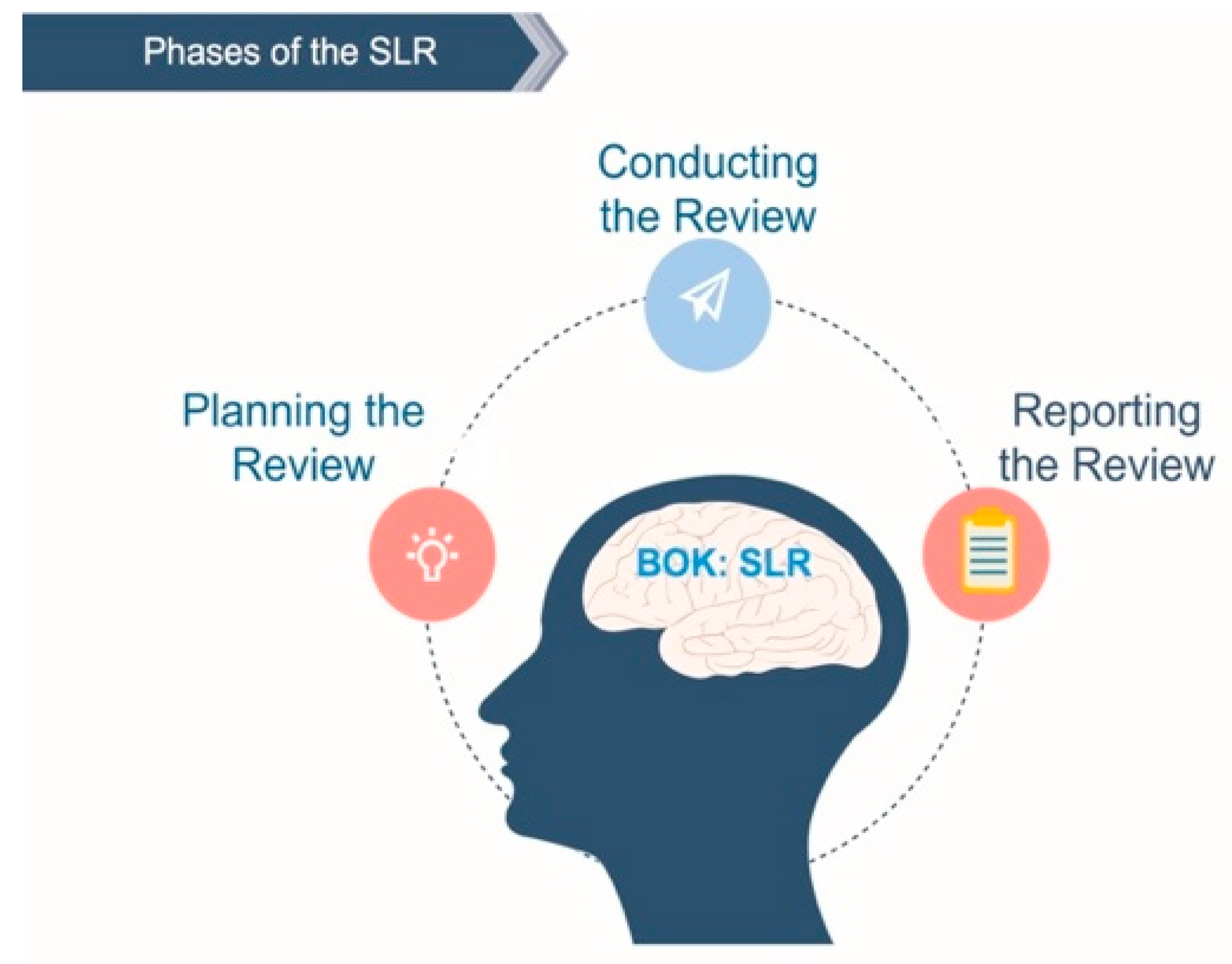
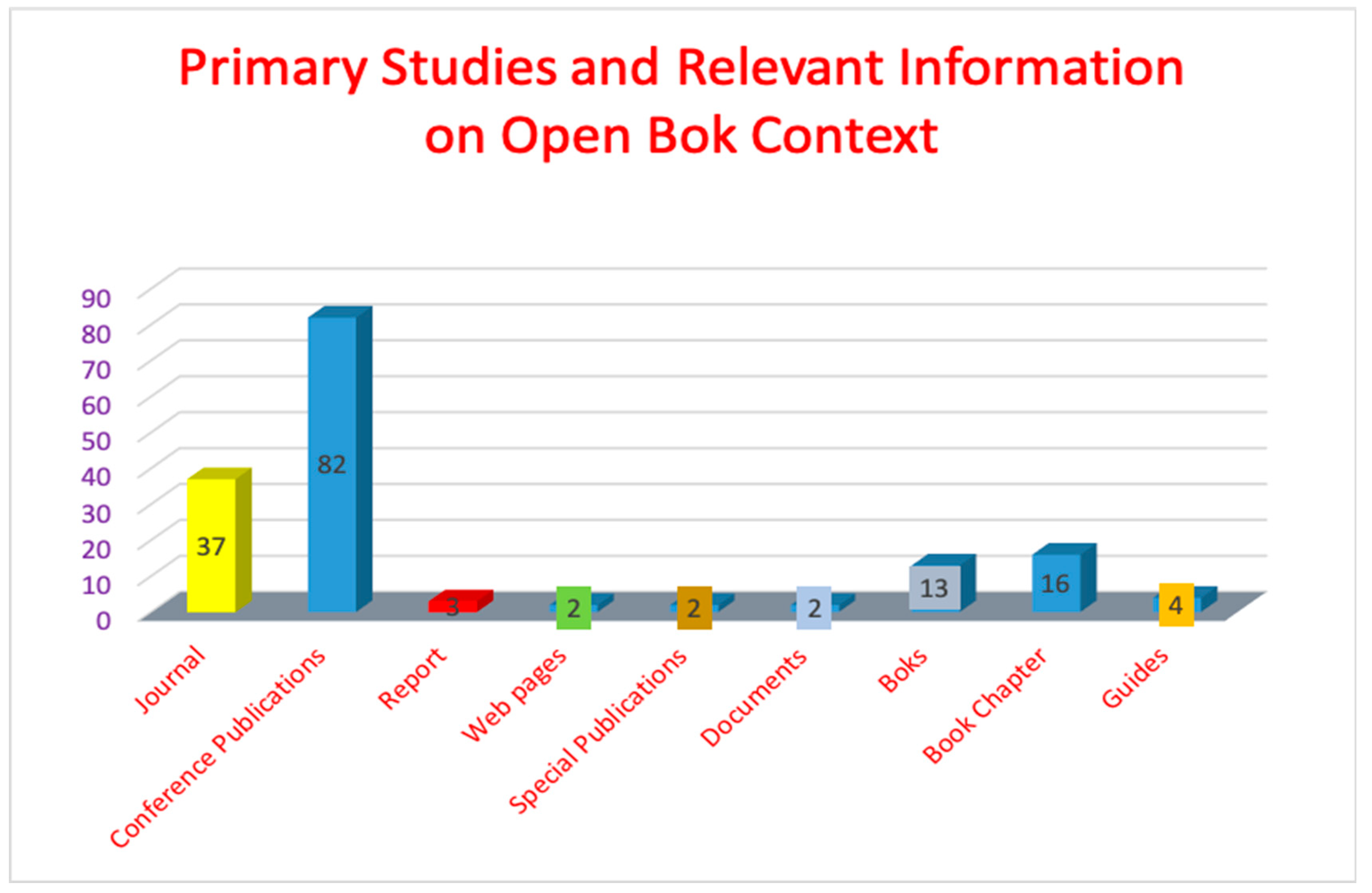
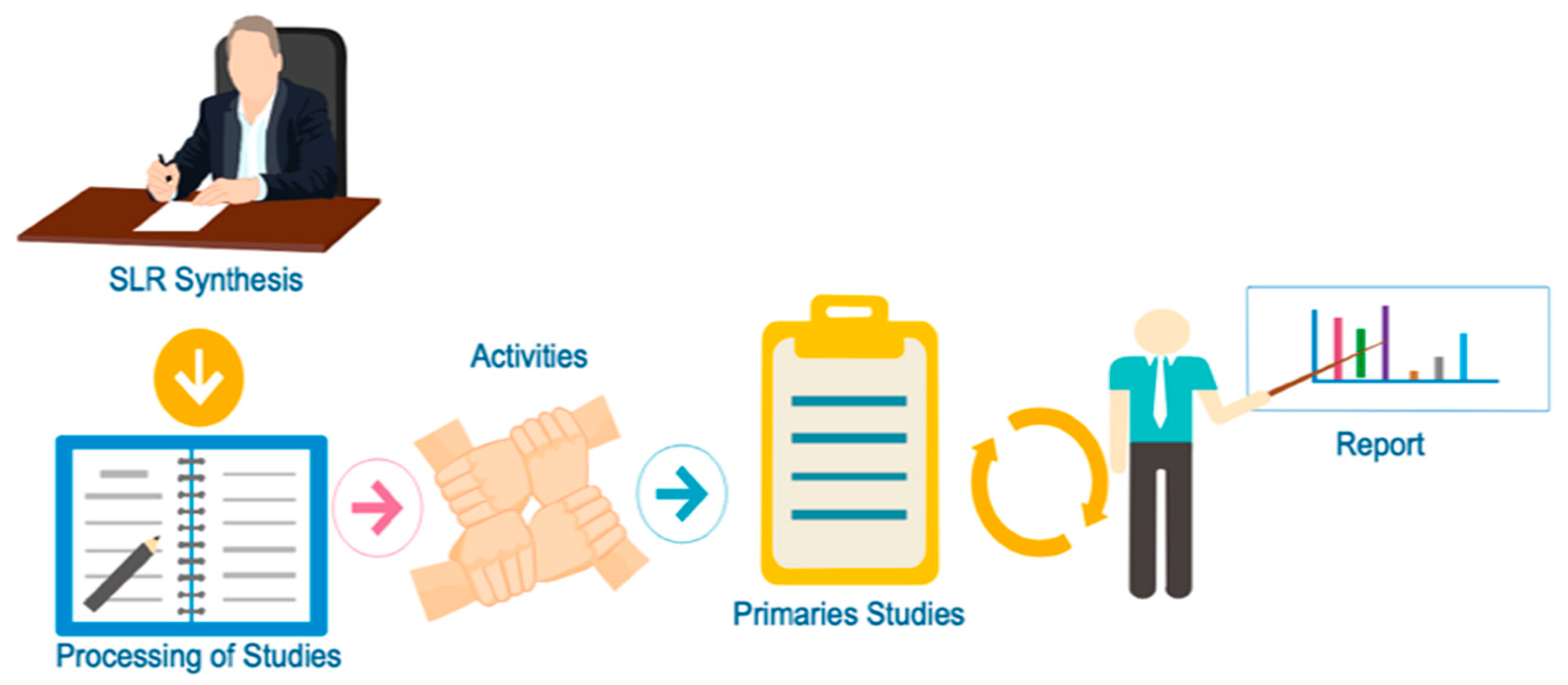
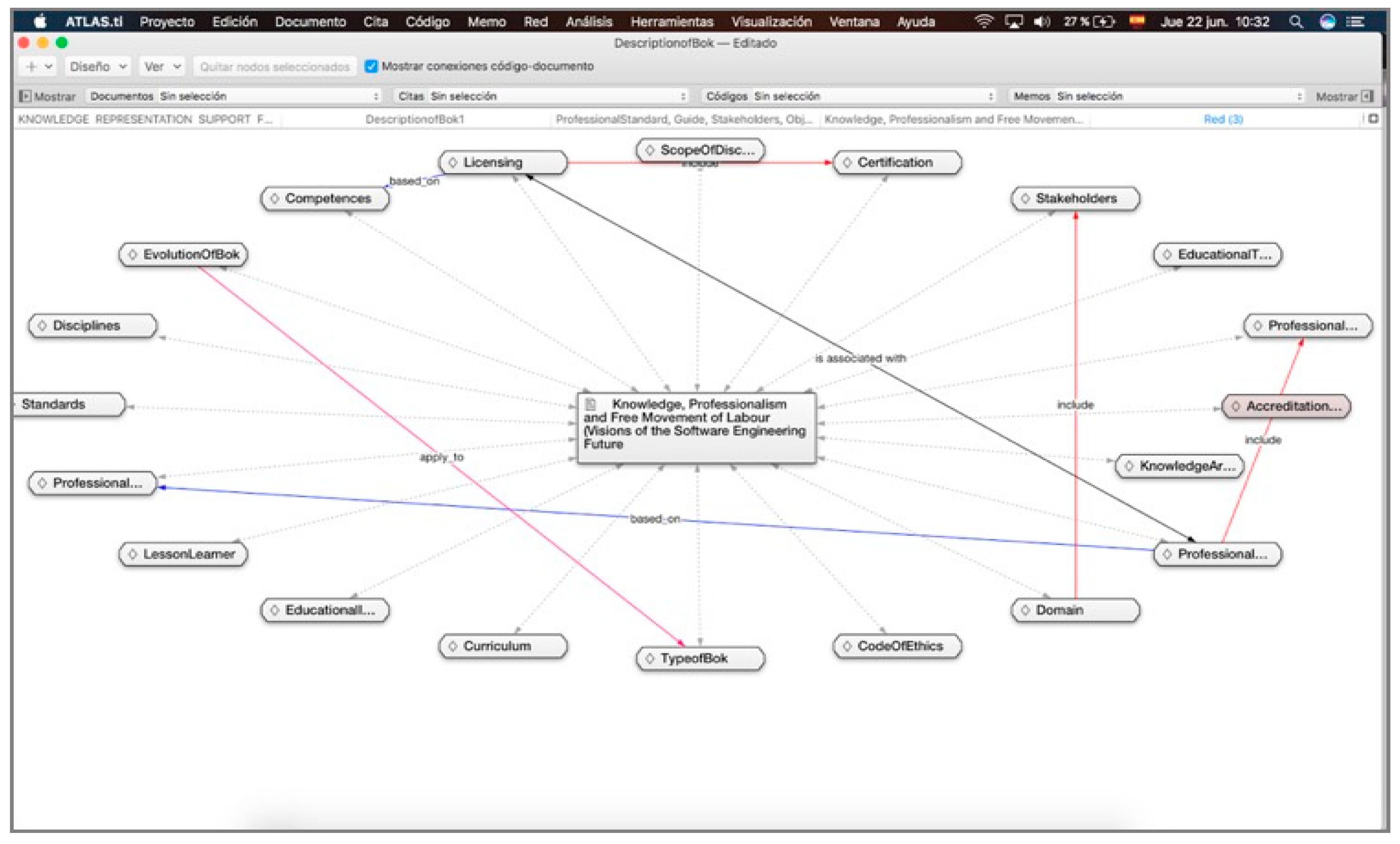

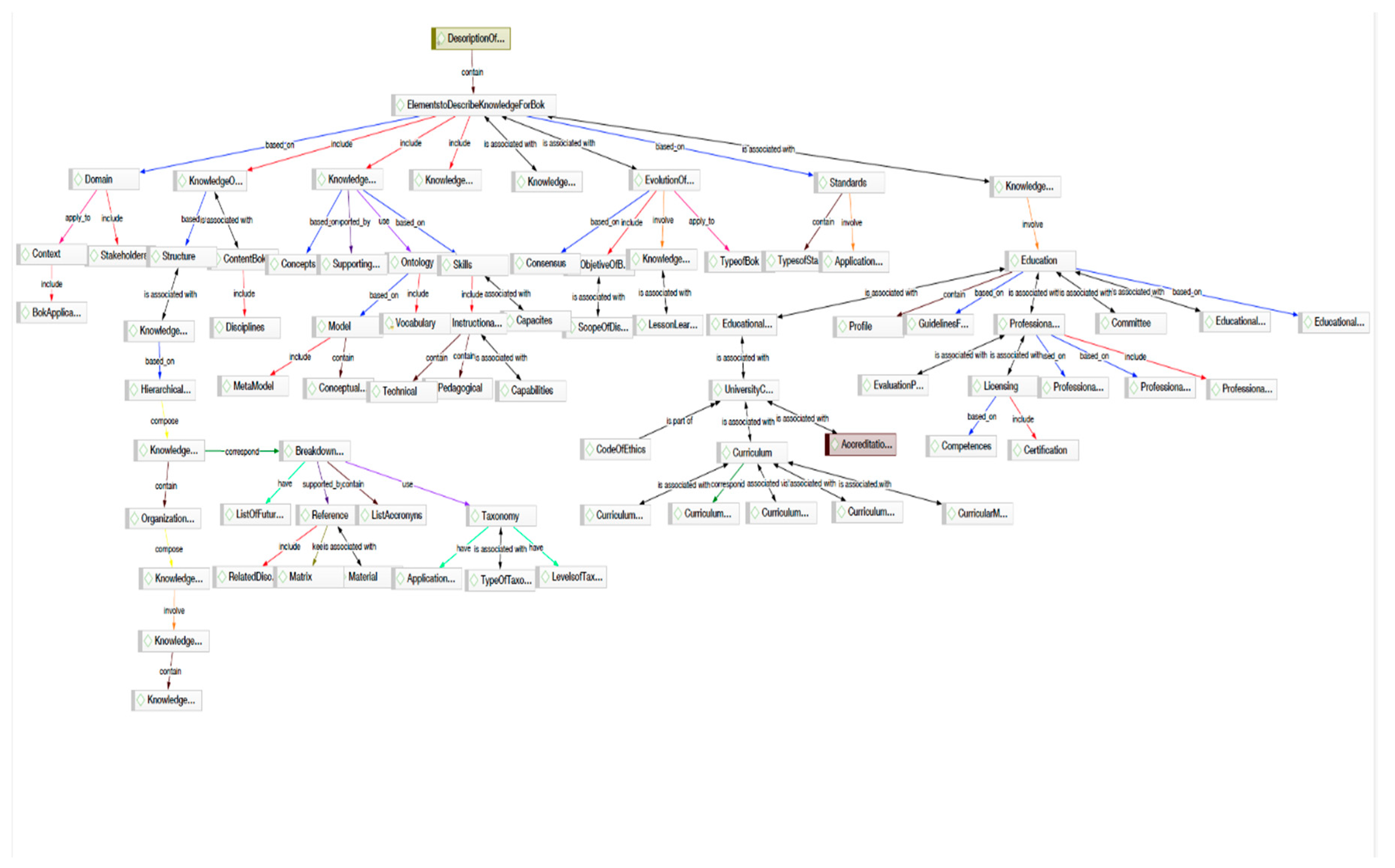
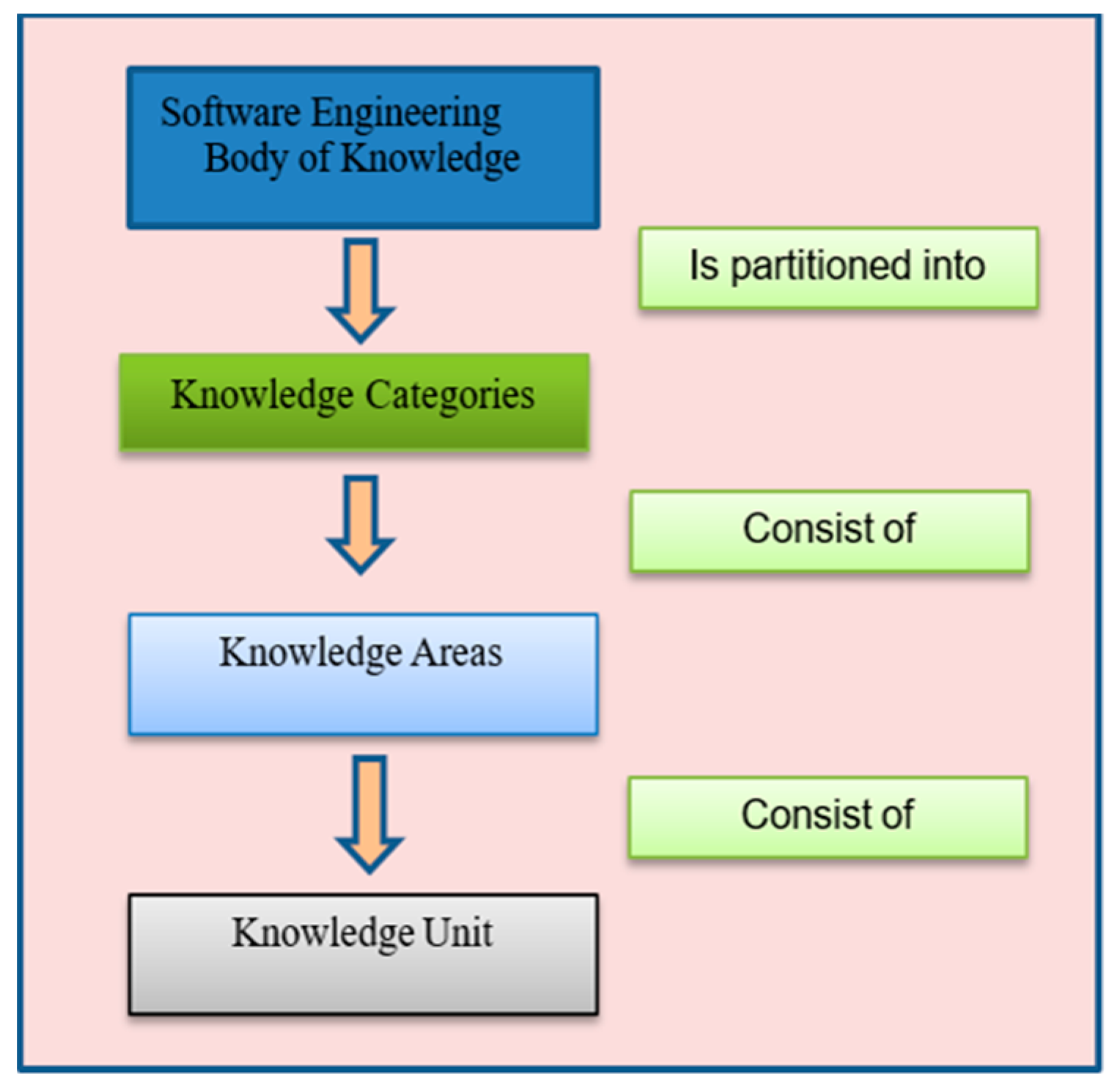
| Database | Retrieved | Include | Exclude |
|---|---|---|---|
| IEEE Xplore Digital Library | 144 | 91 | 53 |
| ACM Digital Library | 27 | 24 | 3 |
| Springer | 29 | 22 | 7 |
| Web of Science | 7 | 6 | 1 |
| Science Direct | 13 | 12 | 1 |
| Total | 220 | 155 | 65 |
| Year | Journal | Conference Publications | Report | Web Pages | Special Publications | Documents | Book Chapter | Guides | BOK | Total |
|---|---|---|---|---|---|---|---|---|---|---|
| 1959 | 1 | |||||||||
| 1980 | 1 | |||||||||
| 1990 | 2 | |||||||||
| 1995 | 1 | |||||||||
| 1997 | 2 | |||||||||
| 1998 | 1 | |||||||||
| 1999 | 2 | 3 | 1 | 1 | 1 | |||||
| 2000 | 1 | 2 | ||||||||
| 2001 | 6 | 1 | ||||||||
| 2002 | 1 | 5 | 1 | |||||||
| 2003 | 1 | 5 | ||||||||
| 2004 | 2 | 1 | 1 | 1 | 1 | |||||
| 2005 | 6 | 1 | ||||||||
| 2006 | 3 | 4 | 6 | 6 | ||||||
| 2007 | 1 | 9 | 2 | |||||||
| 2008 | 2 | 2 | 1 | 1 | ||||||
| 2009 | ||||||||||
| 2010 | 2 | 4 | 1 | |||||||
| 2011 | 3 | 6 | 2 | 1 | ||||||
| 2012 | 5 | 3 | 1 | |||||||
| 2013 | 1 | 9 | 1 | 1 | ||||||
| 2014 | 1 | 10 | 2 | 1 | ||||||
| 2015 | 3 | 2 | ||||||||
| 2016 | 2 | 1 | 1 | |||||||
| 2017 | ||||||||||
| 2018 | 2 | 1 | 1 | |||||||
| 2019 | 1 | |||||||||
| 2020 | 2 | 1 | 1 | |||||||
| 37 | 82 | 3 | 2 | 2 | 2 | 16 | 4 | 13 | 161 |
| Topic: Article Name | Score | Notes |
|---|---|---|
| 1. Is this a research paper? | ||
| 1.1 Is the paper based on research (or is it merely a “lessons learned” report based on expert opinion)? | ||
| 2. Is there a clear statement of the aims of the research? | ||
| 2.1. Is there a rationale for why the study was undertaken? | ||
| 2.2. Is there a clear statement of the study’s primary outcome (i.e., time-to-market, cost, or product or process quality)? | ||
| 3. Is there an adequate description of the context in which the research was carried out? | ||
| 4. Was the research design appropriate to address the aims of the research? | ||
| 4.1. Has the researcher justified the research design (e.g., have they discussed how they decided which methods to use)? | ||
| 4.2. Is the research design is appropriate for the research goals? | ||
| 5. Was the recruitment strategy appropriate to the aims of the research? | ||
| 5.1. Has the researcher explained how the participants or cases were identified and selected? | ||
| 5.2. Are the cases defined and described precisely? | ||
| 5.3. Were the cases representative of a defined population? | ||
| 5.4. Have the researchers explained why the participants or cases they selected were the most appropriate to provide access to the type of knowledge sought by the study? | ||
| 5.5. Was the sample size sufficiently large? | ||
| 6. Was there a control group with which to compare treatments? | ||
| 6.1. How were the controls selected? | ||
| 6.2. Were they representative of a defined population? | ||
| 7. Was the data collected in a way that addressed the research issue? | ||
| 7.1. Were all measures clearly defined (e.g., unit and counting rules)? | ||
| 7.2. Is it clear how data was collected (e.g., semi-structured interviews, focus group etc.)? | ||
| 7.3. Has the researcher justified the methods that were chosen? | ||
| 7.4. Has the researcher made the methods explicit (e.g., is there an indication of how interviews were conducted, did they use an interview guide)? | ||
| 7.5. Whether the form of the data is clear (e.g., tape recording, video material, notes etc.) | ||
| 7.6. Whether quality control methods were used to ensure completeness and accuracy of data collection? | ||
| 8. Was the data analysis sufficiently rigorous? | ||
| 8.1. Was there an in-depth description of the analysis process? | ||
| 8.2. Has sufficient data been presented to support the findings? | ||
| 8.3. To what extent has contradictory data been taken into account? | ||
| 8.4. Whether quality control methods were used to verify the results | ||
| 9. Has the relationship between researcher and participants been considered adequately? | ||
| 9.1. Did the researcher critically examine their own role, potential bias and influence during the formulation of research questions, sample recruitment, data collection, and analysis and selection of data for presentation? | ||
| 10. Is there a clear statement of findings? | ||
| 10.1. Are the findings explicit (e.g., magnitude of effect)? | ||
| 10.2. Has an adequate discussion of the evidence, both for and against the researcher’s arguments, been demonstrated? | ||
| 10.3. Has the researcher discussed the credibility of their findings (e.g., triangulation, respondent validation, more than one analyst)? | ||
| 10.4. Are limitations of the study discussed explicitly? | ||
| 10.5. Are the findings discussed in relation to the original research questions? | ||
| 10.6. Are the conclusions justified by the results? | ||
| 11. Is the study of value for research or practice? | ||
| 11.1. Does the researcher discuss the contribution the study makes to existing knowledge or understanding (e.g., do they consider the findings in relation to current practice or relevant research-based literature)? | ||
| 11.2. Does the research identify new areas in which research is necessary? | ||
| 11.3. Does the researcher discuss whether or how the findings can be transferred to other populations, or consider other ways in which the research can be used? | ||
| Scale | ||
| Not mention the topic | 0 | |
| The topic is slightly analysis | 1 | |
| The topic is show partially | 2 | |
| The topic is mention totally | 3 | |
| Include | 20 | |
| Exclude | −20 | |
| Body of Knowledge Name | Structure | Versions |
|---|---|---|
| B1: BOK for MPM [40]. | The Structure of the BOK has been outlined to identify the various knowledge, and skills required by today’s medical practice executive [40]. | Three versions [39]. |
| B2: Usability Body of Knowledge [41]. | The Body of Knowledge is organized in an architectural hierarchy [41]. | Conditions, and circumstances that are relevant to an event, fact or knowledge, in the process of being organized. |
| B3: The Personal Software Process (PSP) Body of Knowledge [42]. | This BOK is organized in an architectural hierarchy in which the concepts and skills of the PSP are described and decomposed into three levels of abstraction [42]. | Unique version [42]. |
| B4: SLA BOK [43]. | The SLA BOK is organized by competency clusters and knowledge areas. Individual competencies (CMP) include skills, related competencies, examples and high maturity skills [43]. | Unique version [43]. |
| B5: SWEBOK [3]. | Hierarchical structure using different levels of topics. | Three version [3]. |
| B6: PMBOK [44]. | Hierarchical structure using different levels of topics. | Six versions [44]. |
| B7: ITS BOK [45]. | Structured by well-defined competencies, notional security roles, four primary functional perspectives, and an IT Security Role, Competency, and Functional Matrix. | Unique version [45]. |
| B8: WEBOK [46]. | Hierarchical structure using different levels of topics [46]. | Unique version [49]. |
| B9: ITBOK. | Hierarchical structure. 13 knowledge areas [46]. | Unique version [46]. |
| B10: SEBOK [47]. | Sevent parts. | SEBOK has versions 1.0 to 1.4 with very small changes in between [47]. |
| B11: BKCASE [48]. | The BKCASE project is of courses structured similarly as the SEBOK itself [48]. | Three versions [48]. |
| B12: EABoK [68] | Hierarchical structure. | Unique version [68]. |
| Elements | Association | Description |
|---|---|---|
| C1. Domain | C1.1 Context | Knowledge identified by name, context, and application. |
| C1.1.1 BOK Application | ||
| C1.2 Stakeholders | ||
| C1.3 Education | ||
| C1.4 Industry | ||
| C2. Knowledge Organization | C2.1 BOK Content | The conditions, and circumstances that are relevant to an event, fact or knowledge, in the process of being organized. |
| C2.1.1 Disciplines | ||
| C2.2 Structure | ||
| C2.2.1 Knowledge Categories | ||
| C2.2.2 Hierarchical Organization | ||
| C2.2.2.1 Knowledge Areas | ||
| C2.2.2.1.1 Organization of Knowledge Area | ||
| C2.2.2.1.2 Breakdown of Topics | ||
| C2.2.2.1.2.1 List of Future Readings | ||
| C2.2.2.1.2.2 List of Acronyms | ||
| C2.2.2.1.2.3 References | ||
| C2.2.2.1.2.3.1 Materials | ||
| C2.2.2.1.2.3.2 Matrix | ||
| C2.2.2.1.2.3.3 Related Disciplines | ||
| C2.2.2.1.2.4 Taxonomies | ||
| C2.2.2.1.2.4.1 Types of Taxonomies | ||
| C2.2.2.1.2.4.2 Levels of Taxonomies | ||
| C2.2.2.1.2.4.3Application of Taxonomies | ||
| C2.2.2.1.3 Knowledge Organization | ||
| C2.2.2.1.3.1 Knowledge Unit | ||
| C2.2.2.1.3.1.1 Knowledge Topic | ||
| C2.2.2.1.3.1.2 Knowledge Subtopic | ||
| C3. Knowledge Representation | C3.1 Concepts | Characteristics to represent knowledge in an educational context. |
| C3.2 Supporting Tools | ||
| C3.3 Ontology | ||
| C3.3.1 Models | ||
| C3.3.2 Vocabulary | ||
| C3.4. Skills | ||
| C3.4.1.1Instructional Skills | ||
| C3.4.1.1.1 Types of Skills | ||
| C3.4.1.1.1.1 Technical | ||
| C3.4.1.1.1.2 Pedagogical | ||
| C3.4.1.2 Capacities | ||
| C3.4.1.3 Capabilities | ||
| C4. Domain Management | C4.1. BOK Areas | Structure of BOKs, where topics are thoroughly detailed. |
| C4.2 BOK Details | ||
| C4.3 BOK Structure | ||
| C5. Knowledge Acquisition | C5.1Types of Standards | Ways to acquire Knowledge. |
| C5.2 Application of Standards | ||
| C6. Evolution Boks | C6.1 Consensus | Any process of formation, growth or development in the BOK context. |
| C6.2 BOK Objective | ||
| C6.2.1 Scope of BOK | ||
| C6.3 Type of BOK | ||
| C6.4 Knowledge Acquisition | ||
| C6.4.1 Lessons Learned | ||
| C6.4.2 Material | ||
| C7. Knowledge Resource | C7.1 Guides | Resources about the BOK. |
| C7.2 Communities | ||
| C7.3 Standards | ||
| C8. Knowledge Education | C8.1 Education | A set of characteristics that identify a knowledge within the educational context |
| C8.1.1 Profile | ||
| C8.1.2 Guidelines for Profiles | ||
| C8.1.3 Educational Institution | ||
| C8.1.4 Educational Training | ||
| C8.1.4.1University Curricula | ||
| C8.1.4.1.1 Curriculum | ||
| C8.1.4.1.1.1Curriculum Process | ||
| C8.1.4.1.1.2 Curriculum Develop | ||
| C8.1.4.1.1.3Curriculum Resource | ||
| C8.1.4.1.1.4 Curriculum Architecture | ||
| C8.1.4.1.1.5 Code of Ethics | ||
| C8.1.4.2 BOK Accreditation | ||
| C8.1.5 Professional Certification | ||
| C8.1.5.1 Evaluation Policies | ||
| C8.1.5.2 Licensing | ||
| C8.1.5.2.1 Competences | ||
| C8.1.5.2.2 Certification | ||
| C8.1.5.3 Professional Standard | ||
| C8.1.5.4 Professional Practice | ||
| C8.1.5.5 Professional Development | ||
| C8.1.6 Educational Objectives | ||
| C8.1.7 Committees | ||
| C8.1.8 Innovation |
© 2020 by the authors. Licensee MDPI, Basel, Switzerland. This article is an open access article distributed under the terms and conditions of the Creative Commons Attribution (CC BY) license (http://creativecommons.org/licenses/by/4.0/).
Share and Cite
Quezada-Sarmiento, P.A.; Elorriaga, J.A.; Arruarte, A.; Washizaki, H. Open BOK on Software Engineering Educational Context: A Systematic Literature Review. Sustainability 2020, 12, 6858. https://doi.org/10.3390/su12176858
Quezada-Sarmiento PA, Elorriaga JA, Arruarte A, Washizaki H. Open BOK on Software Engineering Educational Context: A Systematic Literature Review. Sustainability. 2020; 12(17):6858. https://doi.org/10.3390/su12176858
Chicago/Turabian StyleQuezada-Sarmiento, Pablo Alejandro, Jon A. Elorriaga, Ana Arruarte, and Hironori Washizaki. 2020. "Open BOK on Software Engineering Educational Context: A Systematic Literature Review" Sustainability 12, no. 17: 6858. https://doi.org/10.3390/su12176858
APA StyleQuezada-Sarmiento, P. A., Elorriaga, J. A., Arruarte, A., & Washizaki, H. (2020). Open BOK on Software Engineering Educational Context: A Systematic Literature Review. Sustainability, 12(17), 6858. https://doi.org/10.3390/su12176858







